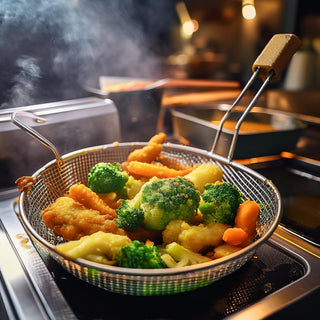| Rank | Seedling | Nutritional Highlights | Health Benefits | Cooking Methods to Preserve Nutrients | Cooking Methods That Reduce Nutrients |
|---|---|---|---|---|---|
| 1 | 🥬 Kale | High in vitamins A, C, and K, calcium, potassium, iron | Supports immune health, bone strength, and anti-inflammatory effects | Steaming: Light steaming retains nutrients. Sautéing: Quick sautéing with olive oil helps absorb fat-soluble vitamins. | Boiling: Can leach water-soluble vitamins. Overcooking: Destroys heat-sensitive nutrients like vitamin C. |
| 2 | 🥗 Spinach | Rich in vitamins A, C, and K, magnesium, iron, folate | Promotes eye health, reduces oxidative stress, supports cardiovascular health | Sautéing: Briefly sauté with garlic or olive oil. Steaming: Retains iron and vitamins. Blanching: Quickly blanching preserves nutrients. | Boiling: Loses significant nutrients in water. Overcooking: Can diminish nutrients and flavor. |
| 3 | 🥦 Broccoli | High in vitamins C and K, folate, fiber, sulforaphane | Supports detoxification, cancer prevention, and bone health | Steaming: Retains sulforaphane and vitamin C. Stir-frying: Cook quickly to preserve nutrients. Microwaving: Use minimal water to retain vitamins. | Boiling: Nutrient loss occurs in cooking water. Deep Frying: Adds unhealthy fats and destroys some nutrients. |
| 4 | 🌱 Brussels Sprouts | High in vitamins C and K, fiber, antioxidants | May reduce inflammation, improve blood sugar control, and protect against cancer | Roasting: Enhances flavor and retains nutrients. Steaming: Maintains vitamins and minerals. Sautéing: Add a splash of lemon juice for extra vitamin C. | Boiling: Nutrient loss in water. Overcooking: Creates unpleasant odor and reduces nutrients. |
| 5 | 🌿 Chard (Silverbeet) | High in vitamins A, C, and K, magnesium, potassium | Supports heart health, reduces blood pressure, and aids in blood sugar control | Sautéing: Quick sauté with garlic and olive oil preserves nutrients. Steaming: Retains most vitamins and minerals. Stir-frying: Fast cooking with minimal oil maintains nutrients. | Boiling: Leaches out vitamins and minerals. Overcooking: Destroys nutrients and alters flavor. |
| 6 | 🥕 Beetroot | High in folate, manganese, potassium, nitrates | Supports blood pressure regulation, improves exercise performance | Roasting: Enhances natural sweetness and retains nutrients. Boiling: Use minimal water to avoid nutrient loss. Steaming: Maintains nutrients effectively. | Long Boiling: Loses nitrates and vitamins. Overcooking: Reduces natural flavors and nutrients. |
| 7 | 🥬 Cabbage | Rich in vitamins C and K, fiber, antioxidants | Supports digestion, heart health, and reduces inflammation | Stir-frying: Quick cooking retains nutrients. Fermentation: Sauerkraut maintains nutrients and adds probiotics. Steaming: Preserves vitamins and minerals. | Boiling: Causes significant nutrient loss. Overcooking: Destroys nutrients and flavor. |
| 8 | 🥬 Lettuce | Good source of vitamins A and K, folate, fiber | Supports hydration, digestion, and heart health | Raw: Use in salads for maximum nutrient retention. Wrapping: Use as a wrap to preserve crispness and nutrients. Juicing: Retains vitamins and minerals in liquid form. | Cooking: Often reduces crispness and nutrients. Boiling: Leaches out vitamins. |
| 9 | 🥕 Carrots | High in beta-carotene (vitamin A), fiber, antioxidants | Supports eye health, immune function, and skin health | Steaming: Preserves beta-carotene. Roasting: Enhances natural sweetness without nutrient loss. Microwaving: Retains most vitamins and minerals. | Boiling: Loses water-soluble vitamins in water. Deep Frying: Adds unhealthy fats and reduces nutrients. |
| 10 | 🥒 Cucumber | High water content, vitamins K and C, potassium | Supports hydration, skin health, and may aid in weight loss | Raw: Eat fresh for hydration and maximum nutrient retention. Pickling: Fermentation adds probiotics without losing nutrients. Juicing: Retains vitamins and antioxidants. | Cooking: Can lose water content and crunch. Boiling: Reduces vitamins and freshness. |
Key Considerations for Cooking:
-
Boiling: This method can lead to significant nutrient loss, especially for water-soluble vitamins like vitamin C and B vitamins. Nutrients often leach into the water, which is usually discarded.
-
Deep Frying: Adds unhealthy fats and can destroy some nutrients due to high temperatures. This method should be used sparingly if the goal is to preserve nutritional value.
-
Overcooking: Extended cooking times can destroy heat-sensitive nutrients and negatively affect flavor and texture.
-
Microwaving, Steaming, and Stir-frying: These are generally healthier cooking methods as they preserve most nutrients, especially when done with minimal water and oil.
-
Fermentation: Preserves and sometimes enhances nutrients while adding beneficial probiotics, particularly in vegetables like cabbage.




